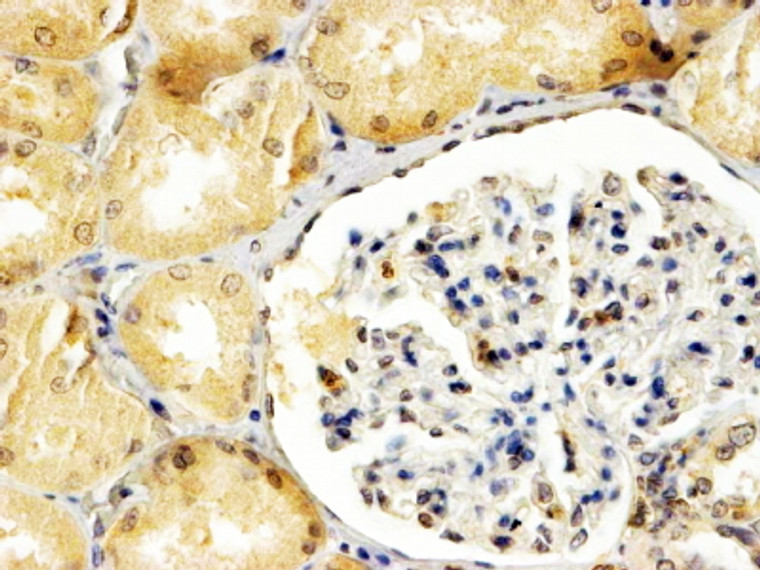| Host: |
Goat |
| Applications: |
Pep-ELISA/IHC |
| Reactivity: |
Human |
| Note: |
STRICTLY FOR FURTHER SCIENTIFIC RESEARCH USE ONLY (RUO). MUST NOT TO BE USED IN DIAGNOSTIC OR THERAPEUTIC APPLICATIONS. |
| Short Description: |
Goat polyclonal antibody anti-APOBEC3G/ARP9 (Internal) is suitable for use in ELISA and Immunohistochemistry research applications. |
| Clonality: |
Polyclonal |
| Conjugation: |
Unconjugated |
| Isotype: |
IgG |
| Formulation: |
0.5 mg/ml in Tris saline, 0.02% sodium azide, pH7.3 with 0.5% bovine serum albumin. NA |
| Purification: |
Purified from goat serum by ammonium sulphate precipitation followed by antigen affinity chromatography using the immunizing peptide. |
| Concentration: |
0.5 mg/mL |
| Dilution Range: |
IHC-Recommended concentration, 1-2µg/mlELISA-antibody detection limit dilution 1:64000. |
| Storage Instruction: |
Store at-20°C on receipt and minimise freeze-thaw cycles. |
| Gene Symbol: |
APOBEC3G |
| Gene ID: |
60489 |
| Uniprot ID: |
ABC3G_HUMAN |
| Immunogen Region: |
Internal |
| Accession Number: |
NP_068594.1 |
| Immunogen Sequence: |
SKWRKLHRDQE |
| Post Translational Modifications | Ubiquitinated in the presence of HIV-1 Vif. Association with Vif targets the protein for proteolysis by the ubiquitin-dependent proteasome pathway. Phosphorylation at Thr-32 reduces its binding to HIV-1 Vif and subsequent ubiquitination and degradation thus promoting its antiviral activity. |
| Function | DNA deaminase (cytidine deaminase) which acts as an inhibitor of retrovirus replication and retrotransposon mobility via deaminase-dependent and -independent mechanisms. Exhibits potent antiviral activity against Vif-deficient HIV-1. After the penetration of retroviral nucleocapsids into target cells of infection and the initiation of reverse transcription, it can induce the conversion of cytosine to uracil in the minus-sense single-strand viral DNA, leading to G-to-A hypermutations in the subsequent plus-strand viral DNA. The resultant detrimental levels of mutations in the proviral genome, along with a deamination-independent mechanism that works prior to the proviral integration, together exert efficient antiretroviral effects in infected target cells. Selectively targets single-stranded DNA and does not deaminate double-stranded DNA or single- or double-stranded RNA. Exhibits antiviral activity also against simian immunodeficiency viruses (SIVs), hepatitis B virus (HBV), equine infectious anemia virus (EIAV), xenotropic MuLV-related virus (XMRV) and simian foamy virus (SFV). May inhibit the mobility of LTR and non-LTR retrotransposons. |
| Protein Name | Dna Dc->Du-Editing Enzyme Apobec-3gApobec-Related Cytidine DeaminaseApobec-Related ProteinArcdApobec-Related Protein 9Arp-9Cem-15Cem15Deoxycytidine DeaminaseA3g |
| Database Links | Reactome: R-HSA-180585Reactome: R-HSA-180689 |
| Cellular Localisation | CytoplasmNucleusP-BodyMainly CytoplasmicSmall Amount Are Found In The NucleusDuring Hiv-1 InfectionVirion-Encapsidated In Absence Of Hiv-1 Vif |
| Alternative Antibody Names | Anti-Dna Dc->Du-Editing Enzyme Apobec-3g antibodyAnti-Apobec-Related Cytidine Deaminase antibodyAnti-Apobec-Related Protein antibodyAnti-Arcd antibodyAnti-Apobec-Related Protein 9 antibodyAnti-Arp-9 antibodyAnti-Cem-15 antibodyAnti-Cem15 antibodyAnti-Deoxycytidine Deaminase antibodyAnti-A3g antibodyAnti-APOBEC3G antibodyAnti-MDS019 antibody |
Information sourced from Uniprot.org
12 months for antibodies. 6 months for ELISA Kits. Please see website T&Cs for further guidance







